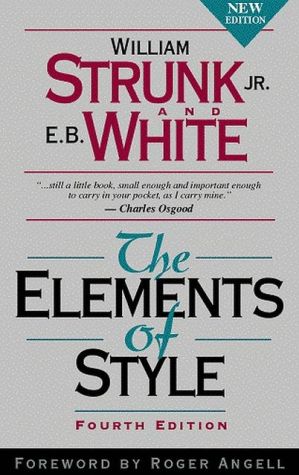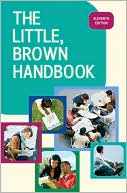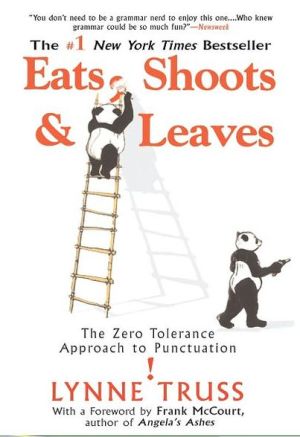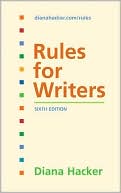The Chicago Manual of Style, 16th Edition
While digital technologies have revolutionized the publishing world in the twenty-first century, one thing still remains true: The Chicago Manual of Style is the authoritative, trusted source that writers, editors, and publishers turn to for guidance on style and process. For the sixteenth edition, every aspect of coverage has been reconsidered to reflect how publishing professionals work today. Though processes may change, the Manual continues to offer the clear, well-considered style and...
Search in google:
The Sixteenth Edition is available in book form and as a subscription website. The same content from The Chicago Manual of Style is in both versions.While digital technologies have revolutionized the publishing world in the twenty-first century, one thing still remains true: The Chicago Manual of Style is the authoritative, trusted source that writers, editors, and publishers turn to for guidance on style and process. For the sixteenth edition, every aspect of coverage has been reconsidered to reflect how publishing professionals work today. Though processes may change, the Manual continues to offer the clear, well-considered style and usage advice it has for more than a century.The sixteenth edition offers expanded information on producing electronic publications, including web-based content and e-books. An updated appendix on production and digital technology demystifies the process of electronic workflow and offers a primer on the use of XML markup, and a revised glossary includes a host of terms associated with electronic as well as print publishing. The Chicago system of documentation has been streamlined and adapted for a variety of online and digital sources. Figures and tables are updated throughout the book—including a return to the Manual’s popular hyphenation table and new, comprehensive listings of Unicode numbers for special characters.With the wisdom of a hundred years of editorial practice and a wealth of industry expertise from both Chicago’s staff and an advisory board of publishing professionals, The Chicago Manual of Style, 16th edition, is an invaluable resource in this rapidly changing world. If you work with words—no matter what the delivery medium—this is the one reference you simply must have. New York Times Paper Cuts Blog "As an equal-opportunity usage geek, I’m excited. . . . The new edition’s press materials come with a 19-point bulleted list of what’s fresh, including an electronic-editing checklist, all sorts of guidelines for e-publishing (XML workflow, anyone?), and — here’s where they had me — a whole new section on parallel structure! (Swoon.) The book contains an ''expanded section on bias-free language,'' which in this cultural moment I might have titled the ''wishful thinking'' section. And it promises ''firmer rules and clearer recommendations,'' which was striking, considering the seemingly inexorable trend away from firmness in matters of grammar and usage, especially online."—New York Times Paper Cuts Blog
Preface AcknowledgmentsPart One: The Publishing Process1 Books and Journal2 Manuscript Preparation, Manuscript Editing, and Proofreading3 Illustrations and Tables4 Rights, Permissions, and Copyright AdministrationPart Two: Style and Usage5 Grammar and Usage6 Punctuation7 Spelling, Distinctive Treatment of Words, and Compounds8 Names and Terms9 Numbers10 Abbreviations11 Foreign Languages12 Mathematics in Type13 Quotations and DialoguePart Three: Documentation14 Documentation I: Notes and Bibliography15 Documentation II: Author- Date References16 IndexesAppendix A: Production and Digital Technology Appendix B: Glossary Bibliography Index
\ New Yorker“The Sixteenth Edition of the Chicago Manual of Style is here, and it''s hard for some of us to contain our excitement. . . . For those of us who spend our days worrying over words, there really is something thrilling—or at least comforting—about the arrival of the newest incarnation of this venerable guide.”—New Yorker\ \ \ \ \ \ \ Chicago TribuneBound, famously, in orange and thicker with each new edition, the 104-year-old reference classic has kept watch over the publication of hundreds of great books and thousands of not-so-great ones, an arbiter and aide-de-camp for editors trying to decide how to handle items in a list, punctuation within quotes or, these days, the proper hexadecimal code for the German double low-9 quotation mark (201E, as you probably suspected).”\ — Steve Johnson\ \ \ \ New York Times Paper Cuts Blog"As an equal-opportunity usage geek, I’m excited. . . . The new edition’s press materials come with a 19-point bulleted list of what’s fresh, including an electronic-editing checklist, all sorts of guidelines for e-publishing (XML workflow, anyone?), and — here’s where they had me — a whole new section on parallel structure! (Swoon.) The book contains an 'expanded section on bias-free language,' which in this cultural moment I might have titled the 'wishful thinking' section. And it promises 'firmer rules and clearer recommendations,' which was striking, considering the seemingly inexorable trend away from firmness in matters of grammar and usage, especially online."\ \ \ \ \ \ The Writing Resource\ — Erin Brenner\ \ \ \ \ The Stranger"For over one hundred years, The Chicago Manual of Style has been setting and defending stylistic standards. In a world where we often communicate with just our thumbs and publish our thoughts from 30,000 feet in the air, we need something to ground us, to solve the little problems, to give us answers we never knew we needed, and to make us beam (or scream) with solutions to the dilemma of the omitted antecedent of a relative pronoun."—Stranger, Seattle\ \ \ \ \ \ Copyediting[The sixteenth edition] is nothing if not acutely digitally aware. . . . Efficient, intuitive navigation and searching are the hallmark of CMS 16 online.”\ — Charles M. Levin\ \ \ \ \ \ Times Literary SupplementCMS is marked by unfaltering good sense; and a good index and numbered paragraphs make it easily navigable. . . . Such is the book’s scope that it addresses itself to everything from the most straightforward conventions of layout . . . to submission requirements for authors and broader concerns such as editorial judgment.”\ — Catharine Morris\ \ \ \ \ \ BookforumThis iteration has a jacket the calming shade of a robin's egg or one of those old Mac screens, and you can imagine a weary copy editor cooling her tired brow against it. It has about a hundred more pages than the fourteenth and a crisper font.”\ — Ed Park\ \ \ \ \ \ SeattleFor over one hundred years, The Chicago Manual of Style has been setting and defending stylistic standards. In a world where we often communicate with just our thumbs and publish our thoughts from 30,000 feet in the air, we need something to ground us, to solve the little problems, to give us answers we never knew we needed, and to make us beam (or scream) with solutions to the dilemma of the omitted antecedent of a relative pronoun.\ — Stranger\ \ \ \ \ \ Choice“The online version of the manual provides a clean, intuitive interface for users accustomed to print reference sources, with a hyperlinked table of contents on the main page.”\ \ \ \ \ \ Booklist“Chicago’s granite-solid strength abides in the familiar guidance generations of editors and scholars have depended upon—how to treat punctuation, names, numbers, tables, quotations, dialogue, abbreviations, etc. Users will welcome the streamlined approach to documentation, introducing greater consistency between the author-date and the notes-bibliography citation systems. This is the first edition of The Chicago Manual of Style to be published simultaneously in print and online. Either way, no library serving serious authors can be without it.”\ \ \ \ \ \ New Yorker Book Bench Blog“The Sixteenth Edition of the Chicago Manual of Style is here, and it's hard for some of us to contain our excitement. . . . For those of us who spend our days worrying over words, there really is something thrilling—or at least comforting—about the arrival of the newest incarnation of this venerable guide.”\ \ \ \ \ \ Chicago Tribune“Bound, famously, in orange and thicker with each new edition, the 104-year-old reference classic has kept watch over the publication of hundreds of great books and thousands of not-so-great ones, an arbiter and aide-de-camp for editors trying to decide how to handle items in a list, punctuation within quotes or, these days, the proper hexadecimal code for the German double low-9 quotation mark (201E, as you probably suspected).”\ \ \ \ \ \ Seattle"For over one hundred years, The Chicago Manual of Style has been setting and defending stylistic standards. In a world where we often communicate with just our thumbs and publish our thoughts from 30,000 feet in the air, we need something to ground us, to solve the little problems, to give us answers we never knew we needed, and to make us beam (or scream) with solutions to the dilemma of the omitted antecedent of a relative pronoun."\ \ \ \ \ \ Times Literary Supplement“CMS is marked by unfaltering good sense; and a good index and numbered paragraphs make it easily navigable. . . . Such is the book’s scope that it addresses itself to everything from the most straightforward conventions of layout . . . to submission requirements for authors and broader concerns such as editorial judgment.”\ \ \ \ \ \ Bookforum“This iteration has a jacket the calming shade of a robin's egg or one of those old Mac screens, and you can imagine a weary copy editor cooling her tired brow against it. It has about a hundred more pages than the fourteenth and a crisper font.”\ \ \ \ \ \ Copyediting“[The sixteenth edition] is nothing if not acutely digitally aware. . . . Efficient, intuitive navigation and searching are the hallmark of CMS 16 online.”\ \ \ \ \ \ Chicago Tribune“Bound, famously, in orange and thicker with each new edition, the 104-year-old reference classic has kept watch over the publication of hundreds of great books and thousands of not-so-great ones, an arbiter and aide-de-camp for editors trying to decide how to handle items in a list, punctuation within quotes or, these days, the proper hexadecimal code for the German double low-9 quotation mark (201E, as you probably suspected).”—Steve Johnson, Chicago Tribune\ — Steve Johnson\ \ \ \ \ \ Bookforum“This iteration has a jacket the calming shade of a robin''s egg or one of those old Mac screens, and you can imagine a weary copy editor cooling her tired brow against it. It has about a hundred more pages than the fourteenth and a crisper font.”—Ed Park, Bookforum\ — Ed Park\ \ \ \ \ \ Times Literary Supplement“CMS is marked by unfaltering good sense; and a good index and numbered paragraphs make it easily navigable. . . . Such is the book’s scope that it addresses itself to everything from the most straightforward conventions of layout . . . to submission requirements for authors and broader concerns such as editorial judgment.”—Catharine Morris, Time Literary Supplement\ — Catharine Morris\ \ \ \ \ \ Copyediting“[The sixteenth edition] is nothing if not acutely digitally aware. . . . Efficient, intuitive navigation and searching are the hallmark of CMS 16 online.”—Charles M. Levine, Copyediting\ — Charles M. Levin\ \ \ \ \ \ New York Times Paper Cuts Blog"As an equal-opportunity usage geek, I’m excited. . . . The new edition’s press materials come with a 19-point bulleted list of what’s fresh, including an electronic-editing checklist, all sorts of guidelines for e-publishing (XML workflow, anyone?), and — here’s where they had me — a whole new section on parallel structure! (Swoon.) The book contains an ''expanded section on bias-free language,'' which in this cultural moment I might have titled the ''wishful thinking'' section. And it promises ''firmer rules and clearer recommendations,'' which was striking, considering the seemingly inexorable trend away from firmness in matters of grammar and usage, especially online."—New York Times Paper Cuts Blog\ \ \ \ \ \ The Writing Resource"The 16th edition has been restructured for digital publishing, making it more relevant, and has stopped waffling on many rules, making it easier to use. If you already use CMS, I’d strongly urge you to update to the 16th edition. It’s not a small update, and it just may resolve many of the issues you’ve been dealing with."—The Writing Resource\ \ — Erin Brenner\ \ \ \ \ \ Library JournalThe new go-to publishing manual is here! Responding to the demands made of publishing professionals in the digital age, the 16th edition continues to provide information for word lovers but has enhanced its guidelines to include electronic workflow and processes. For example, a new section delves into electronic markup and XML. While its front pages cover topics similar to those of the previous edition, the Documentation section has been expanded to provide guidelines for notes and bibliographies, as well as for author-date references. There is updated information on DOIs versus URLs, as well as an introduction to Unicode, the international computing standard. Appendix A covers production and digital technology, while Appendix B expands the glossary to include electronic publishing terms, such as bitmap, character encoding, and document type definition. In another bow to our changing production styles, there is an expanded section on bias-free writing. For the first time, the manual is available both in print and online simultaneously. This venerable bible also has a new pastel blue bookjacket to alert users to the style, usage, and technology updates within, though the familiar orange cloth lies below. BOTTOM LINE A worthy, welcome addition to every library collection as well as professional wordsmiths and educated readers of all persuasions.—Marilyn Searson Lary, formerly with North Georgia Coll. & State Univ., Dahlonega\ \







